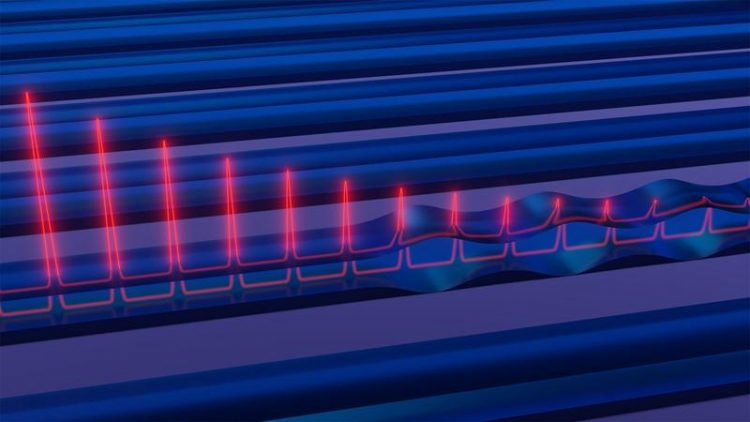Light, sound, action: extending the life of sound waves

Symbol image: Light pulses refresh acoustic waves Image: Max Planck Institute for the Science of Light
Future tech, high-speed internet as well as radar and sensor technology, requires the low-heat, fast transmission of information. Chips using light and sound, rather than electricity, could meet this demand:
They use sound waves, known as phonons, to store and transfer the information they receive from fibre-optic cables. This allows the chips to operate without needing electrons, which produce heat.
However, information transferred from light waves into sound waves decays in nanoseconds, which is not long enough for applications. Birgit Stiller, who leads an independent research group at the Max Planck Institute for the Science of Light, developed a new technique to refresh these acoustic phonons in a project together with Moritz Merklein from the Eggleton Research Group at the University of Sydney and Christian Wolff from the University of Southern Denmark.
Refreshing acoustic waves through light
“What we have done is use carefully timed synchronised pulses of light to reinforce the sound waves,” said Birgit Stiller. “We have shown for the first time that refreshing these phonons is possible and that information can therefore be stored and processed for a much longer time.”
The scientists were able to extend the lifetime of the information stored in sound waves on the chip by 300 percent, from 10 nanoseconds to 40 nanoseconds.
“We plan to use this method to further extend how long the information remains on-chip,” said Moritz Merklein. And Christian Wolff added: “Theoretically this concept can be extended to the microsecond regime.”
“So far, the storage was fundamentally limited by the lifetime of the sound waves. Refreshing the acoustic waves allows us to overcome this constraint,” Birgit Stiller said.
This proof-of-principle demonstration opens many possibilities for optical signal processing, fine filtering, high-precision sensing and telecommunications.
The research, published in the journal Optica, was done in collaboration with the University of Sydney, the Australian National University and the University of Southern Denmark.
Dr Birgit Stiller, birgit.stiller@mpl.mpg.de
Birgit Stiller, Moritz Merklein, Christian Wolff, Khu Vu, Pan Ma, Stephen J. Madden, and Benjamin J. Eggleton, “Coherently refreshing hypersonic phonons for light storage”, Optica 7 (5), 492-492 (2020), https://doi.org/10.1364/OPTICA.386535
Media Contact
More Information:
http://www.mpl.mpg.deAll latest news from the category: Physics and Astronomy
This area deals with the fundamental laws and building blocks of nature and how they interact, the properties and the behavior of matter, and research into space and time and their structures.
innovations-report provides in-depth reports and articles on subjects such as astrophysics, laser technologies, nuclear, quantum, particle and solid-state physics, nanotechnologies, planetary research and findings (Mars, Venus) and developments related to the Hubble Telescope.
Newest articles

A ‘language’ for ML models to predict nanopore properties
A large number of 2D materials like graphene can have nanopores – small holes formed by missing atoms through which foreign substances can pass. The properties of these nanopores dictate many…

Clinically validated, wearable ultrasound patch
… for continuous blood pressure monitoring. A team of researchers at the University of California San Diego has developed a new and improved wearable ultrasound patch for continuous and noninvasive…

A new puzzle piece for string theory research
Dr. Ksenia Fedosova from the Cluster of Excellence Mathematics Münster, along with an international research team, has proven a conjecture in string theory that physicists had proposed regarding certain equations….



